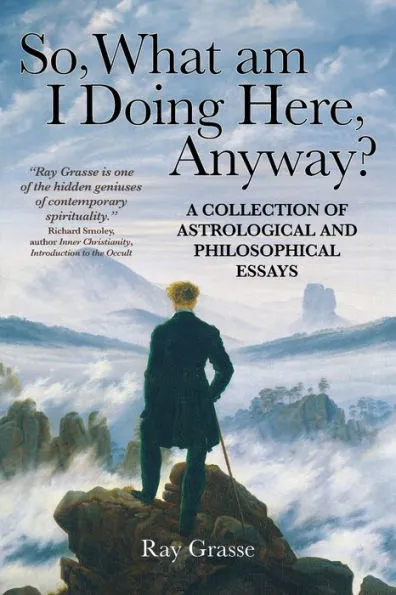Great books help us to learn astrology. A book like Ray Grasse’s new essay collection points to why astrology is worth practicing in the first place.
Grasse is a decades-long editor of The Mountain Astrologer magazine and has also worked with the Theosophical Society’s Quest Magazine. He’s a painter, a filmmaker, a photographer, a student in some of the major meditation traditions.
The title of this collection, So, What am I Doing Here, Anyway? frames some intertwined questions. How does Grasse do astrology? Why does astrology exist? and across eras and cultures? Why do we exist?
Some of the essays bear directly on astrological techniques, and they’re thought-provoking. Grasse starts with a pithy piece about Sun sign astrology. Because one out of every twelve people have the same Sun sign, what’s the use? Grasse’s point is that it’s worth knowing, broadly, how different people are, based even generally on whether they’re from Brazil, Germany, or Japan. Don’t underestimate something as fundamental as Sun signs, is his point. There’s value in generalities.
Grasse studies what he calls “resurrectional transits.” Transits to the charts of people who’ve died, especially famous people, seem to reverberate long after their deaths. There’s often renewed public interest in an artist’s work or in events surrounding a now-deceased public figure. Why? Grasse’s explanation is key to his view of astrology. A natal chart continues working “because it is an imprint in the cosmic mind. Whereas the physical body comes and goes, the horoscope has a life of its own. Unlike a purely physical entity or phenomenon, the chart is essentially a mental phenomenon in the mind of—dare I say it? – God, Allah, Brahma, or as Plotinus called it, the One.”
The natal chart as a “cosmic imprint” explains why astrologies are plural and diverse, from the Hindu-based schools, to the Mayan, Aztec, Egyptian, Chinese, to the contemporary western practice of psychological astrology. A “symbolic text can be read on different levels,” just like scholars can interpret a great literary work in many ways, all of them valid. There’s no need to call one astrology correct and another not. Grasse posits that “a given civilization comes up with precisely the sky-maps and belief systems symbolically appropriate to that culture at that time.”
How does astrology work, though? Grasse recalls that a few months after the 9/11 attack in New York, he was checking his ephemeris for the daily transits when he noticed that Mars in Pisces was forming a stressful t-square with the Saturn/Pluto opposition, the most striking aspect on 9/11/2001. Later, on December 22, 2001, a man boarding an American Airlines flight was caught trying to set off explosives hidden in his shoes. The symbolism was uncanny and unnerving. Pisces rules the feet. Mars is explosive and makes war. An international incident ensued when a man tried to wage war by literally setting his feet on fire.
To the extent that astrology “works,” it does so symbolically, linking earthly and celestial phenomena. Astrology is an application of the esoteric principle of correspondences.
Grasse elaborates in his essay, “Toward a Grand Unified Theory of Synchronicity.” Here he’s not talking about isolated incidences that seem to prove the theorem “as above, so below.” He departs from Carl Jung’s notion of synchronicity because, for Grasse, “individual human psychologies needn’t even be present or involved for ‘synchronicities’ to occur.” Grasse proposes a transpersonal “symbolist” worldview that “regards the cosmos as akin to a great dream,” where “synchronicity is the key to a dramatically different cosmology than what is suggested by conventional science… a worldview that is both multi-leveled in meanings and levels, and interconnected in ways far beyond what the literal eye can possibly perceive.”
He carries this symbolist view into his last essay, “Legends of the Fall,” an archetypal reinterpretation of the Biblical story of Eden. When God told Adam and Eve not to eat from a certain tree and, at the same time, gave them free will, the stage was set for the pair to defy the Creator’s instruction. The expulsion of Adam and Eve into the world of imperfection and hardship is seen in exoteric theology as “a tragic fall into a realm of sin, suffering, and struggle.” But from Grasse’s symbolist view, the fall from perfection is the first step on a path of awakening. As Grasse writes, “it is through our soul’s interaction with this ‘rough’ world and its hardships that something of great beauty arises.” It’s precisely because of our worldly flaws and travails—symbolically displayed in each person’s unique natal map – that “we also learn to develop sensitivity, empathy, and compassion—qualities far harder to come by in idyllic Eden.” The “fall” is an invitation to return to an inner Eden.
That’s what we’re doing here, anyway.
~review by: Sara R. Diamond
Author: Ray Grasse
Wessex Astrologer, 2024
281 pp., $25.00

